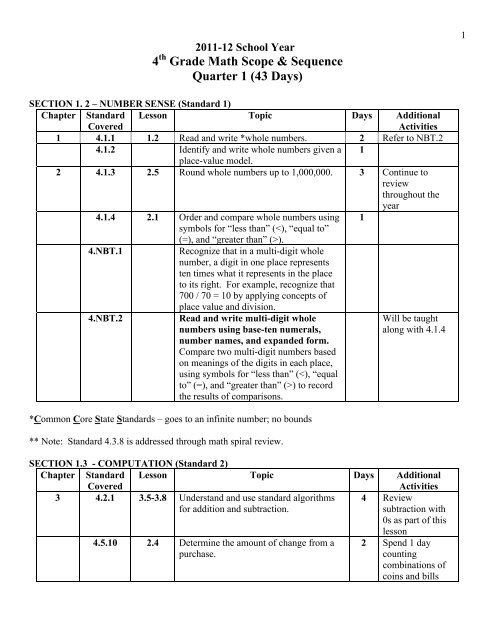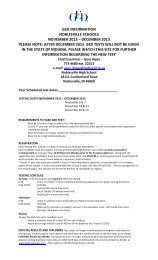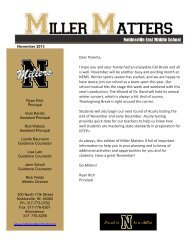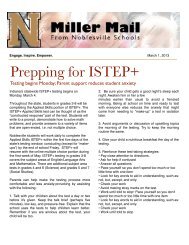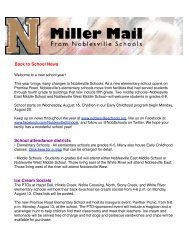Math Curriculum - Noblesville Schools
Math Curriculum - Noblesville Schools
Math Curriculum - Noblesville Schools
You also want an ePaper? Increase the reach of your titles
YUMPU automatically turns print PDFs into web optimized ePapers that Google loves.
2011-12 School Year<br />
4 th Grade <strong>Math</strong> Scope & Sequence<br />
Quarter 1 (43 Days)<br />
SECTION 1. 2 – NUMBER SENSE (Standard 1)<br />
Chapter Standard Lesson Topic Days Additional<br />
Covered<br />
Activities<br />
1 4.1.1 1.2 Read and write *whole numbers. 2 Refer to NBT.2<br />
4.1.2 Identify and write whole numbers given a<br />
place-value model.<br />
1<br />
2 4.1.3 2.5 Round whole numbers up to 1,000,000. 3 Continue to<br />
review<br />
throughout the<br />
year<br />
4.1.4 2.1 Order and compare whole numbers using<br />
symbols for “less than” ().<br />
1<br />
4.NBT.1 Recognize that in a multi-digit whole<br />
number, a digit in one place represents<br />
ten times what it represents in the place<br />
to its right. For example, recognize that<br />
700 / 70 = 10 by applying concepts of<br />
place value and division.<br />
4.NBT.2 Read and write multi-digit whole<br />
Will be taught<br />
numbers using base-ten numerals,<br />
number names, and expanded form.<br />
Compare two multi-digit numbers based<br />
on meanings of the digits in each place,<br />
using symbols for “less than” () to record<br />
the results of comparisons.<br />
along with 4.1.4<br />
*Common Core State Standards – goes to an infinite number; no bounds<br />
** Note: Standard 4.3.8 is addressed through math spiral review.<br />
SECTION 1.3 - COMPUTATION (Standard 2)<br />
Chapter Standard Lesson Topic Days Additional<br />
Covered<br />
Activities<br />
3 4.2.1 3.5-3.8 Understand and use standard algorithms 4 Review<br />
for addition and subtraction.<br />
subtraction with<br />
0s as part of this<br />
lesson<br />
4.5.10 2.4 Determine the amount of change from a 2 Spend 1 day<br />
purchase.<br />
counting<br />
combinations of<br />
coins and bills<br />
1
SECTION 2. 1 – MULTIPLICATION FACTS<br />
Chapter Standard<br />
Covered<br />
4 4.2.4<br />
4.2.2<br />
4.OA.2<br />
4.0A.1<br />
Lesson Topic Day Additional<br />
s Activities<br />
4.1<br />
Multiplication Facts<br />
1 Properties of<br />
Multiplication and<br />
Represent as multiplication any situation (introduce) Rules<br />
involving repeated addition<br />
of Division<br />
4.2 /4.3<br />
Multiply or divide to solve word<br />
problems involving multiplicative<br />
comparison, e.g., by using drawings and<br />
equations with a symbol for the<br />
unknown number to represent the<br />
problem, distinguishing multiplicative<br />
comparison from additive comparison<br />
Relating Multiplication & Division<br />
Interpret a multiplication equation as a<br />
comparison, e.g., interpret 35 = 5 x 7 as<br />
a statement that 35 is 5 times as many<br />
as 7 and 7 times as many as 5.<br />
Represent verbal statements of<br />
multiplicative comparisons as<br />
multiplication equations.<br />
4.4 Facts to 5 2<br />
4.5 Facts to 10 3 Function<br />
Tables/Algebra<br />
Standards<br />
4.2.4/4.3.6 4.6 11s & 12s 1<br />
4.2.4/4.2.5 4.7 3 Factors 1 Stress Associative<br />
4.3.6 4.2/4.3 Recognize and apply the relationships<br />
between addition and multiplication,<br />
between subtraction and division, and the<br />
inverse relationship between<br />
multiplication and division to solve<br />
problems.<br />
SECTION 2.2 – Multiplying by One Factor<br />
Chapter Standard<br />
Covered<br />
6 4.2.5<br />
1<br />
1<br />
Property/<br />
Lesson Topic Days Additional<br />
Activities<br />
6.1/7.1 Multiplication Patterns 1<br />
6.2/6.4 2 Digit x 1 Digit 2<br />
6.5 Problem Solving Guess & Check 1<br />
2
SECTION 2.3 – Multiplying Two Factors<br />
Chapter Standard<br />
Covered<br />
7 4.2.5<br />
4.NBT.5<br />
(practice process skills)<br />
6.6 3 Digit x 1 Digit 1<br />
6.7 Multiply Greater Numbers 1<br />
Lesson Topic Days Additional<br />
Activities<br />
7.3 Multiplication with 2 Digit Numbers 1<br />
7.4 2 Digits x 2 Digits<br />
Multiply two, two-digit numbers, using<br />
strategies based on place value and the<br />
properties of operations. Illustrate and<br />
explain the calculation by using<br />
equations, rectangular arrays, and/or<br />
area models.<br />
3<br />
*7.6 3 Digit x 2 Digit 1<br />
*7.7 Multiply Greater Numbers<br />
Multiply a whole number up to four<br />
digits by a one-digit whole number, and<br />
multiply two, two-digit numbers, using<br />
strategies based on place value and the<br />
properties of operations. Illustrate and<br />
explain the calculation by using<br />
equations, rectangular arrays, and/or<br />
area models.<br />
1<br />
3
2011-12 School Year<br />
4 th Grade <strong>Math</strong> Scope & Sequence<br />
Quarter 2 (44 Days)<br />
SECTION 2.4 - DIVISION<br />
Chapter Standard Lesson Topic Days Additional<br />
Covered<br />
Activities<br />
8 4.2.6 8.1/8.2 Modeling Division<br />
1<br />
9<br />
4.2.3<br />
4.OA.3<br />
4.2.6<br />
4.3.6<br />
4.NBT.6<br />
Represent as division any situation<br />
involving the sharing of objects or the<br />
number of groups of shared objects.<br />
8.3 Divide with Remainders<br />
Solve multistep word problems posed<br />
with whole numbers and having<br />
whole-number answers using four<br />
operations, including problems in<br />
which remainders must be<br />
interpreted. Represent these<br />
problems using equations with a letter<br />
standing for the unknown quantity.<br />
Assess the reasonableness of answers<br />
using mental computation and<br />
estimation strategies including<br />
rounding.<br />
8.4 Regroup in Division 2<br />
9.2/9.3 Place the first digit of the<br />
quotient/Divide money<br />
*Introduced but not assessed on the Quarter 2 test<br />
*9.4 Zeroes in the Quotient 2<br />
9.5 Problem Solving – Work Backwards 1<br />
*9.6 Divide Greater Numbers<br />
1<br />
Find whole-number quotients and<br />
remainders with up to four-digit<br />
dividends and one-digit divisors,<br />
using strategies based on place value,<br />
the properties of operations, and/or<br />
the relationship between<br />
multiplication and division. Illustrate<br />
and explain the calculation by using<br />
equations, rectangular arrays, and/or<br />
area models.<br />
2 Check by using<br />
multiplication.<br />
2 An application of<br />
this is averaging.<br />
Lessons 10.4 &<br />
10.5 - Averaging
SECTION 3. 2 – MEASUREMENT<br />
Chapter Standard Lesson Topic Days Additional<br />
Covered<br />
Activities<br />
12 4.5.1 12.1/12. Measure length to nearest ¼”, 1/8”, and 3 Count by<br />
7 millimeter<br />
fractions.<br />
Relate to money.<br />
4.5.2 12.2 Inch, foot, yard, mile<br />
Subtract units of length that may require<br />
renaming of feet to inches or meters to<br />
centimeters.<br />
2<br />
4.MD.1<br />
Know relative sizes of measurement<br />
units within one system of units<br />
including km, m, cm; kg, g; lb, oz; L,<br />
mL; hr, min, sec. Within a single<br />
system of measurement express<br />
measurements in a larger unit of<br />
terms of a smaller unit. Record<br />
measurement equivalents in a twocolumn<br />
table. For example: Know<br />
that 1 ft is 12 times as long as 1 inch.<br />
Express the length of a 4 ft. snake as<br />
48 in. Generate a conversion table for<br />
feet and inches listing the number pairs<br />
(1, 12), (2, 24), (3, 36)…<br />
4.MD.1 12.3/12. Volume, weight, and mass to be<br />
4 introduced if time allows<br />
13 4.5.9 13.2 Add time intervals involving hours and<br />
minutes.<br />
4.MD.2<br />
Use the four operations to solve word<br />
problems involving distances,<br />
intervals of time, liquid volumes,<br />
masses of objects, and money<br />
including problems involving simple<br />
fractions or decimals, and problems<br />
that require expressing measurements<br />
given in a larger unit in terms of a<br />
smaller unit. Represent measurement<br />
quantities using diagrams such as<br />
number line diagrams that feature a<br />
measurement scale.<br />
2<br />
1<br />
*CCSS requires<br />
the expression of<br />
larger units<br />
terms of smaller<br />
units in the form<br />
of a table.
SECTION 4. 2 – MEASUREMENT<br />
Chapter Standard<br />
Covered<br />
18 4.5.3<br />
4.5.4<br />
4.5.5<br />
4.5.6<br />
4.MD.3<br />
Lesson Topic Days Additional<br />
Activities<br />
18.1/ Know and use formulas for finding the 2<br />
18.2 perimeters of rectangles and squares.<br />
18.3 Know and use formulas for finding the<br />
areas of rectangles and squares.<br />
Estimate and calculate the area of<br />
rectangular shapes using appropriate<br />
units.<br />
Understand that rectangles with the<br />
same area can have different perimeters<br />
and that rectangles with the same<br />
perimeters can have different areas.<br />
Apply the area and perimeter<br />
formulas for rectangles in real world<br />
and mathematical problems. For<br />
example, find the width of a<br />
rectangular room given the area of the<br />
flooring and the length, by viewing the<br />
area formulas as a multiplication<br />
equation with an unknown factor.<br />
18 4.5.7 18.4 Find areas of shapes by dividing them<br />
into basic shapes such as rectangles.<br />
SECTION 4. 1 – GEOMETRY<br />
• Remember to create a geometry journal.<br />
Chapter Standard<br />
Covered<br />
16 4.4.1<br />
4.G.1<br />
2<br />
2 Find area of<br />
complex figures.<br />
Lesson Topic Days Additional<br />
Activities<br />
16.2/ Identify, describe, and draw rays, right 3 Refer to CCSS.<br />
16.3 angles, acute angles, obtuse angles, and<br />
straight angles using appropriate<br />
mathematical tools and technology.<br />
Note: Indicator 4.4.1 will be extended<br />
to also include measuring simple<br />
angles with a protractor.<br />
Draw points, lines, line segments,<br />
rays, angles (right, acute, obtuse), and<br />
perpendicular and parallel lines.<br />
Identify these in two-dimensional<br />
figures.
4.G.2<br />
4.G.3<br />
4.4.2<br />
Classify two-dimensional figures<br />
based on the presence or absence of<br />
parallel or perpendicular lines, or the<br />
presence or absence of angles of a<br />
specified size. Recognize right<br />
triangles as a category and identify<br />
right triangles.<br />
Recognize a line of symmetry for a<br />
two-dimensional figure as a line<br />
across the figure such that the figure<br />
can be folded along the line into<br />
matching parts. Identify linesymmetric<br />
figures and draw lines of<br />
symmetry.<br />
16.1 Identify, describe, and draw parallel,<br />
perpendicular, and oblique lines<br />
(intersecting) using appropriate<br />
mathematical tools and technology.<br />
4.4.3 16.4 Identify, describe, and draw<br />
parallelograms, rhombuses, and<br />
trapezoids, using appropriate<br />
mathematical tools and technology.<br />
17 4.4.4 17.1 Identify congruent quadrilaterals and<br />
give reasons for congruence using sides,<br />
angles, parallels, and perpendiculars.<br />
4.4.5 17.4 Identify and draw lines of symmetry in<br />
4.MD.5<br />
4.MD.5a<br />
4.MD.6<br />
4.MD.7<br />
polygons.<br />
Recognize angles as geometric shapes<br />
that are formed wherever 2 rays<br />
share a common endpoint, and<br />
understand concepts of angle<br />
measurement<br />
An angle is measured with reference<br />
to a circle with its center at the<br />
common endpoint of the rays, by<br />
considering the fraction of the<br />
circular arc between the points where<br />
the two rays intersect the circle. An<br />
angle that turns through 1/360 of a<br />
circle is called a “one-degree angle”,<br />
and can be used to measure angles.<br />
Measure angles in whole-number<br />
degrees using a protractor. Sketch<br />
angles of specified measure.<br />
Recognize angle measure as additive.<br />
2<br />
2<br />
2<br />
1<br />
1<br />
2<br />
1<br />
Introduce
When an angle is decomposed into<br />
non-overlapping parts, the angle<br />
measure of the whole is the sum of the<br />
angle measures of the parts. Solve<br />
addition and subtraction problems to<br />
find unknown angles on a diagram in<br />
real world and mathematical<br />
problems, e.g., by using an equation<br />
with a symbol for the unknown angle<br />
measure.
2011-12 School Year<br />
4 th Grade <strong>Math</strong> Scope & Sequence<br />
Quarter 3 (45 Days)<br />
SECTION 3.1 – FRACTIONS<br />
Chapter Standard Lesson Topic Days Additional<br />
Covered<br />
Activities<br />
19 4.1.6 19.1 Fractions<br />
1<br />
4.1.5<br />
4.NF.1<br />
4.OA.4<br />
Rename and rewrite whole numbers as<br />
fractions<br />
19.2<br />
Explain why a fraction a/b is equivalent<br />
to a fraction (n x a)/ (n x b) by using<br />
visual fraction models, with attention to<br />
how the number and size of the parts<br />
differ even though the two fractions<br />
themselves are the same size. Use this<br />
principle to recognize and generate<br />
equivalent fractions.<br />
Equivalent Fractions 2<br />
10.1 Factors & Multiples 1<br />
19.3 Equivalent Fractions & Simplest Forms 3<br />
Find all factor pairs for a whole number<br />
in the range 1-100. Recognize that a<br />
whole number is a multiple of each of its<br />
factors. Determine whether a given<br />
whole number in the range 1-100 is<br />
prime or composite.<br />
19.4 Compare & Order Fractions<br />
4.NF.2<br />
Compare two fractions with different<br />
numerators and different denominators,<br />
e.g., by creating common denominators<br />
or numerators, or by comparing to a<br />
benchmark fractions such as 1/2.<br />
Recognize that comparisons are valid<br />
only when the two fractions refer to the<br />
same whole. Record the results of<br />
comparisons with symbols >, =,
SECTION 3.3 – ADD & SUBTRACT FRACTIONS<br />
Chapter Standard<br />
Covered<br />
20 4.2.8<br />
4.NF.3<br />
4.NF.3a<br />
4.NF.3b<br />
4.NF.3c<br />
4.NF.3d<br />
4.NF.4<br />
4.NF.4a<br />
Lesson Topic Days Additional<br />
Activities<br />
20.1 Add & Subtract Fractions with Like<br />
Denominators<br />
2<br />
Understand a fraction a/b where “a” is ><br />
1 as a sum of fractions 1/b.<br />
Understand addition and subtraction of<br />
fractions as joining and separating parts<br />
referring to the same whole.<br />
Decompose a fraction into a sum of<br />
fractions with the same denominator in<br />
more than one way, recording each<br />
decomposition by an equation. Justify<br />
decompositions, e.g., by using a visual<br />
fraction model. Examples: 3/8 = 1/8 +<br />
1/8 + 1/8; 3/8 = 1/8 + 2/8; 2 1/8 = 1 + 1 +<br />
1/8 = 8/8 + 8/8 + 1/8.<br />
Add and subtract mixed numbers with<br />
like denominators, e.g., by replacing<br />
each mixed number with an equivalent<br />
fraction and/or by using properties of<br />
operations and the relationship between<br />
addition and subtraction.<br />
Solve word problems involving addition<br />
and subtraction of fractions referring to<br />
the same whole and having like<br />
denominators, e.g., by using visual<br />
fractions models and equations to<br />
represent the problem.<br />
1<br />
20.6 Add with Unlike Denominators 2<br />
20.7 Subtract with Unlike Denominators 2<br />
Apply and extend previous<br />
understandings of multiplication to<br />
multiply a fraction by a whole number.<br />
1<br />
Understand a fraction a/b as a multiple<br />
of 1/b. For example, use a visual fraction<br />
model to represent 5/4 as the product of 5<br />
x (1/4), recording the conclusion by the<br />
1<br />
Introduce only.<br />
2
4.NF.4b<br />
4.NF.4c<br />
equation 5/4 = 5 x (1/4).<br />
Understand a multiple of a/b as a<br />
multiple of 1/b, and use this<br />
understanding to multiply a fraction by<br />
a whole number. For example, use a<br />
visual fraction model to express 3 x (2/5)<br />
as 6 x (1/5), recognizing this product as<br />
6/5. (In general, n x (a/b) = (n x a)/b.<br />
Solve word problems involving<br />
multiplication of a fraction by a whole<br />
number, e.g., by using visual fraction<br />
models and equations to represent the<br />
problem. For example, if each person at<br />
a party will eat 3/8 of a pound of roast<br />
beef, and there will be 5 people at the<br />
party, how many pounds of roast beef will<br />
be needed? Between what two whole<br />
numbers does your answer lie?<br />
4.NF.5 Express a fraction with denominator 10<br />
as an equivalent fraction with<br />
denominator 100, and use this technique<br />
to add two fractions with respective<br />
denominators 10 and 100. For example,<br />
express 3/10 as 30/100 and add 3/10 +<br />
4/100 = 34/100.<br />
SECTION 3.4 – DECIMALS<br />
Chapter Standard Lesson Topic Days Additional<br />
Covered<br />
Activities<br />
21 4.1.8 21.1 Tenths and Hundredths 2<br />
4.1.8 21.2 Thousandths 1<br />
4.1.6 21.3 Mixed Numbers and Decimals 1<br />
4.1.8 21.4 Fractions & Decimal Equivalents 2<br />
4.NF.6<br />
Use decimal notation for fractions with<br />
denominators 10 or 100. For example,<br />
rewrite 0.62 as 62/100; describe a length<br />
of 0.62 meters; locate 0.62 on a number<br />
line diagram.<br />
4.7.1 21.5 Problem Solving: Find a Pattern 1<br />
4.1.4 21.6 Compare and Order Decimals 2<br />
4.NF.7<br />
Compare two decimals to hundredths by<br />
reasoning about their size. Recognize<br />
that comparisons are valid only when<br />
two decimals refer to the same whole.<br />
Record the results of comparison with<br />
the symbols >, =, or
4.1.4 21.7<br />
conclusions, e.g., by using a visual<br />
model.<br />
Compare and Order Decimals and Mixed<br />
Numbers<br />
SECTION 3.4 – DECIMALS (continued)<br />
Chapter Standard Lesson Topic Days Additional<br />
Covered<br />
Activities<br />
22 4.1.9 22.1 Round two-place decimals to tenths or to 2 Review rounding<br />
the nearest whole number.<br />
whole numbers<br />
first<br />
22 4.2.9 22.3/ Add and subtract decimals (to<br />
1<br />
22.4 hundredths), using objects or pictures.<br />
22 4.2.10 22.4 Use a standard algorithm to add and<br />
subtract decimals (to hundredths).<br />
Note: Do a quick review of 4.5.10.<br />
(Change from a purchase).<br />
1<br />
SECTION 2.5 – ALGEBRA<br />
Chapter Standard Lesson Topic Days Additional<br />
Covered<br />
Activities<br />
5 4.3.3 5.1 Order of Operations 2 Hands on<br />
Equations<br />
4.3.1 5.2 Words into Expressions 1<br />
4.2.4/4.3.1 5.3 Compare Expressions 1<br />
4.3.1 5.4 Variables & Equations 1<br />
4.3.1 5.5 Write an Equation 1<br />
4.3.4 5.6 Function Tables<br />
2<br />
4.OA.5<br />
Generate a number or shape pattern<br />
that follows a given rule. Identify<br />
apparent features of the pattern that<br />
were not explicit in the rule itself. For<br />
example, given the rule “Add 3” and the<br />
starting number 1 generate terms in the<br />
resulting sequence and observe that the<br />
terms appear to alternate between odd<br />
and even numbers. Explain informally<br />
why the numbers will continue to<br />
alternate in this way.<br />
**Note: Standard 4.3.2 and 4.3.5 are addressed in the math spiral review.<br />
1<br />
4
SECTION 4.4 – GRAPHING<br />
2011-12 School Year<br />
4 th Grade <strong>Math</strong> Scope & Sequence<br />
Quarter 4 (49 Days)<br />
Chapter Standard Lesson Topic Days Additional<br />
Covered<br />
Activities<br />
14 4.6.1 14.1 Collect & Organize Data 1<br />
14.2 Problem Solving – Make a Table 1<br />
4.MD.4<br />
*14.3 Mean, Median, Mode & Range 2<br />
14.4 Line Plots<br />
Make a line plot to display a data set of<br />
measurements in fractions of a unit (1/2,<br />
1/4, 1/8). Solve problems involving<br />
addition and subtraction of fractions by<br />
using information presented in line plots.<br />
For example, from a line plot find and<br />
interpret the difference in length between<br />
the longest and shortest specimens in an<br />
insect collection.<br />
15 4.6.2 15.1 Double Bar Graphs 1<br />
15.2 Circle Graphs 1 Computer<br />
Graphing Using<br />
Microsoft Word<br />
or Excel<br />
20 4.6.2 20.8 Using a Circle Graph 1<br />
15.3 Interpret a Line Graph 1<br />
15.4 Read & Make Line Graphs 1<br />
15.5 Analyze Graphs 1<br />
4.6.3 Summarize and display the results of<br />
probability experiments in a clear and<br />
organized way.<br />
1<br />
*Introduced but not assessed on the Quarter 3 test<br />
**Note: After the May ISTEP, revisit the CCSS standards that were introduced in the previous quarters.<br />
2<br />
1


